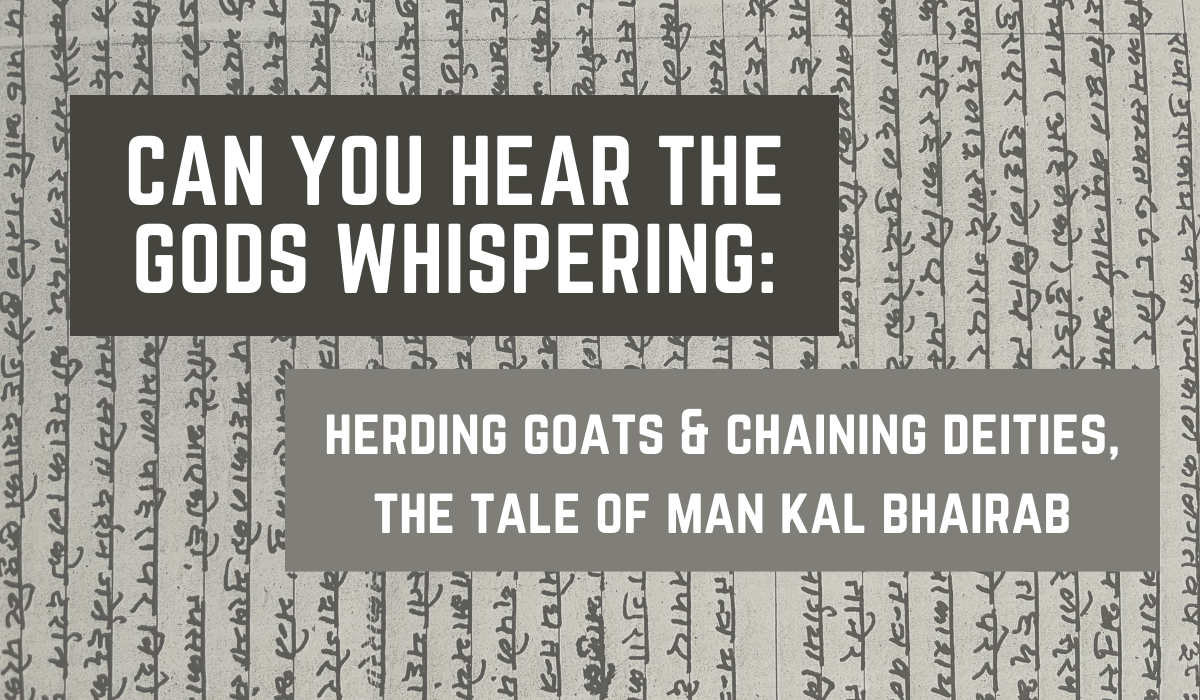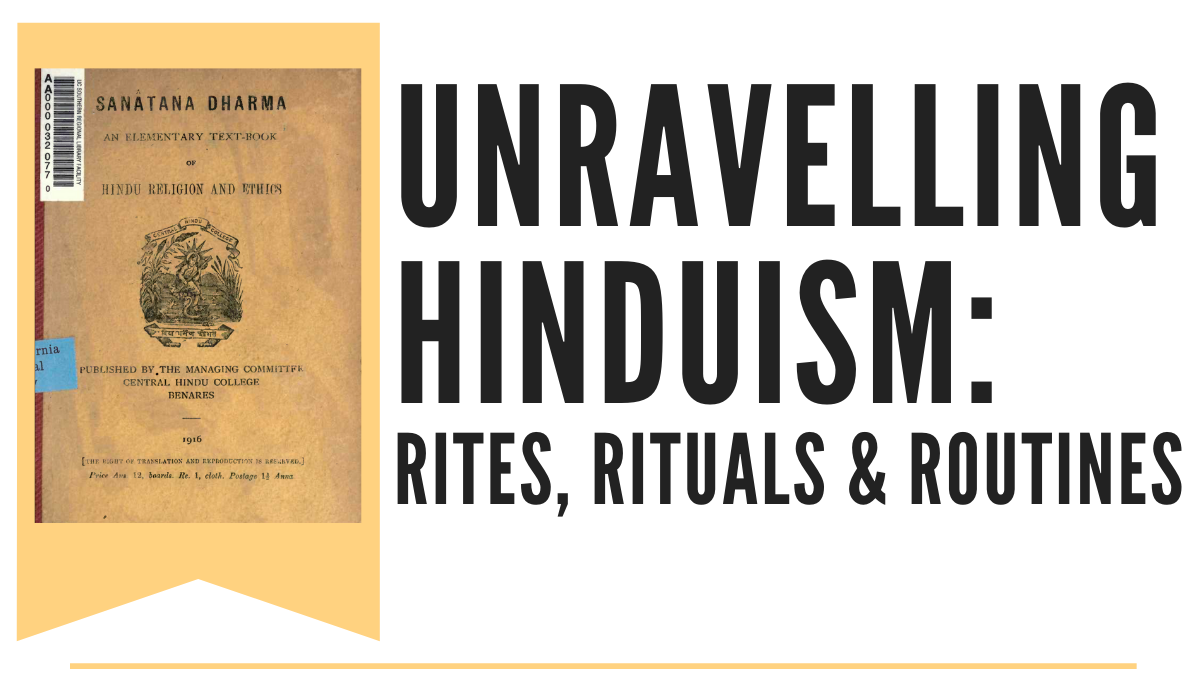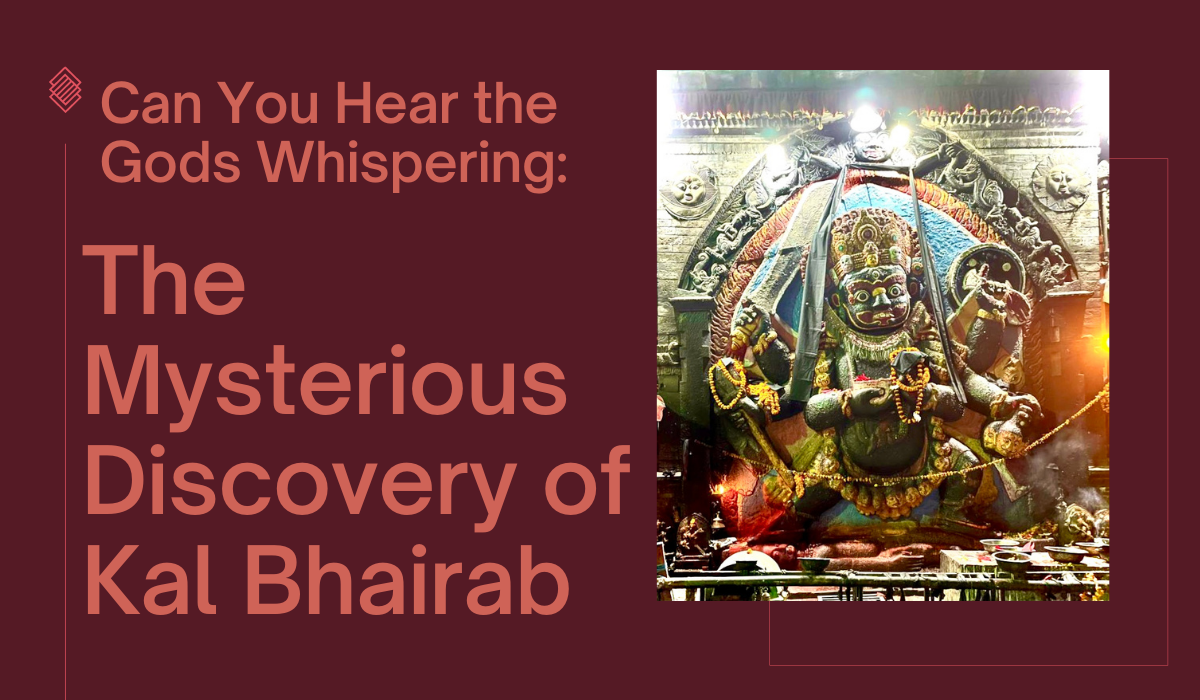Can You Hear the Gods Whispering: Herding Goats and Chaining Deities, The tale of Man Kal Bhairab

Some years ago, I saw a book called “Kathmandu: where the Gods are young.” This title struck me so deeply that even now, almost a decade later I still recall it, even though I never got the chance to open up the book and see what was inside. There was something so profound about the title, it reminded me that I live in a city where the Gods are present at every turn. Each street corner has a small temple or shrine and our cityscape is defined by round Stupas and triangular mandirs. I would see these buildings without fully appreciating what it meant: that this city, this country, it’s history and it’s people are shaped by the divine in a way that I am yet to see in any other nation in the world.
I realised this more fully last year when I read two books, ironically both were completely unrelated to Nepal. “Mythos” and “Heroes” are books by the inimitable Stephen Fry. They are both collections of Ancient Greek Myths retold in an accessible way for modern readers and take us through everything from the Ancient Greek ideas of the creation of the universe all the way up to the famous Ancient Greek heroes and their various feats of triumph. Now you may wonder what all this has to do with Nepal. Well, as I read the stories about Gods coming down from Olympus to shape the course of human lives and to interact with mere mortals, I realised that what was happening in Ancient Greece many millennia ago was happening in our own country mere centuries ago. Of course Nepal is a country where the Gods are young, they were walking among us for thousands of years and even until just a few hundred years ago. We see the marks they have left on our nation even today. I cannot imagine a more spiritually alive country than Nepal.
What follows is a series of short stories that show exactly how intertwined the celestial and the earthly are in our country, and how the cities we live in and the streets we walk are there by divine purpose.
Before we get lost in the wonders of the stories that follow, I would like to pay tribute to the late Mir Subba Shiva Hari Rimal whose knowledge of Hinduism and Nepali history was unparalleled. He shared his wisdom with four generations of my family and I am so pleased to be able to share with our readers these myths and legends that he kept a record of. I hope that in passing along his knowledge I can keep his memory alive and can imbue the same love for Nepal that he had into all of us.
(Please note that what follows does not claim to be a factual, definitive or comprehensive history. These are stories that have been passed down in an oral tradition for many generations. There may be different versions of each of these stories and what is found here is simply one retelling. This article and its associated imagery are in no way meant to cause offence or wipe out any other narratives that may exist regarding these topics.)
Herding goats and Chaining Deities, The tale of Man Kal Bhairab
I am sure that all of us Kathmandu residents have at one point or another driven or walked down the road adjacent to Tudikhel and in so doing passed by the temple of Man Kal Bhairab. I am equally certain that many of us have also stopped outside the mandir (temple), or perhaps even gone inside, to offer our prayers to the imposing murti (statue) housed within the temple. This temple is thought to be the home of a powerful form of Bhairab (one of many Bhairabs found throughout Nepal). Countless devotees pray there but how many of us actually know the story of how Man Kal Bhairab came to reside here in Kathmandu?
The story goes that many years ago, roughly in 3822 kalingata barsa also known as 778 bikram sambat, during the reign of Raja Gune Kaam Dev, a man took his goats to graze in a field located in what is now Tudikhel. Noticing that his goats needed some help in reaching their sustenance, he herded his animals towards a tree and reached up to pull down the low hanging branches so his goats could reach the green and crunchy leaves. Having ensured that his livestock were adequately fed, the goatherd lay down in the shadow of the tree and gazed up at the heavens.
Abruptly the man sat up, surely his eyes must be deceiving him! For he had seen in the sky a large cloud spinning around while it travelled through the air. Intrigued by what he saw and determined to investigate this unusual phenomenon further, the man, being one of considerable tantric (spiritual magic) ability, used his tantrashastra (knowledge of spiritual magic) to pull this wondrous spinning cloud towards the ground. Looking into the cloud the man was blessed with visions of the great Man Kal in his divine and heavenly form.
Having seen this powerful deity, the man made his way to see the king, Raja Gune Kaam Dev. He is believed to have reported to the king the heavenly vision he had seen and convinced the ruler that to use tantric powers to pull this deity towards Kathmandu, and keep him here, would be extremely beneficial to the nation. The protective presence of Man Kal would undoubtedly aid in keeping the nation safe.
The king, having been persuaded by the prospect of the perpetual safety of his kingdom, granted the tantric permission to construct a great statue of Man Kal. Using his considerable powers and memories of his visions, the tantric was able to construct a statue in the likeness of Man Kal. He then prayed to the deity that he would take up residence in this murti and reside forevermore in Kathmandu.
Answering the man’s zealous pleas, Man Kal appeared and asked the man how he expected a powerful and divine traveller who traverses the corners of the universe to live in such a manner forever. Man Kal would not agree to such a fate as this would not be appropriate for a deity such as himself.
However, Man Kal acquiesced that the tantric had indeed succeeded in pulling him toward Kathmandu and therefore agreed that while he would travel the universe indefinitely, every Saturday he would come to reside in the statue the tantric had created of him. Thus, each week Man Kal comes to his abode in Kathmandu and while spending the entire night here he blesses all the devotees that come to him and protects us all.
Given his immense generosity in blessing our city with his presence, the statue of Man Kal is always kept satiated with peda (a traditional Nepali sweet), which visitors to the temple will always see present in the deity’s mouth. If you look closely you will also see that there is a chain placed around the feet of Man Kal Bhairab as a testament to the man who was able to pull a god to the land of mortals. Similarly, every Saturday a special mala (garland) is placed around his neck and the temple is left open throughout the night. On Saturdays Man Kal Bhairab is worshipped with increased ardour by many temple-goers. It is thought that any prayer you make to Man Kal on a Saturday will likely come true and any grahadasha (bad luck) that may have been coming your way will be cleansed away.
So, the next time you make your way down this seemingly ordinary road remember that you walk under the watchful gaze of a god; one who blesses our nation with his presence and protection, all because one day many years ago a man looked up at the clouds.
If you would like to read the first instalment of our “Can You Hear the God Whispering” series, please click the button below.

